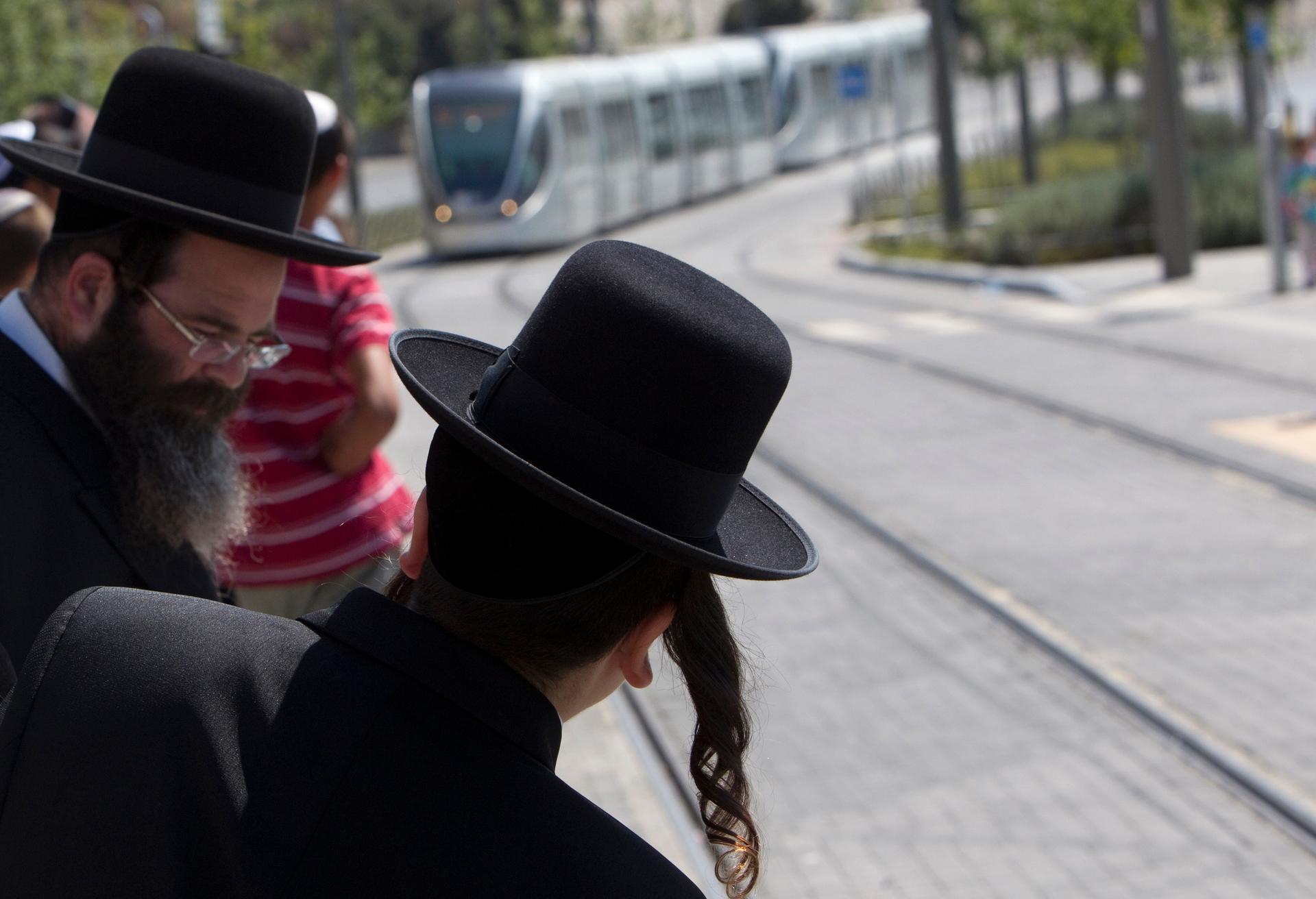Debate over a new light rail line in Jerusalem symbolic of city’s fissures, discontent
Passengers wait at a light rail tram station in Jerusalem in August 2011. (Photo by Ronen Zvulun/Reuters.)
Something shiny and new is winding its way through the streets of Jerusalem. It’s Israel’s first commuter light rail.
It was designed to give Jerusalem’s public transportation a much needed upgrade.
But it charges right through the city’s sensitive geopolitics — and it’s upsetting locals for all kinds of reasons.
You could call it the streetcar that few desire. But Jerusalem’s new light rail does give the city a fresh look.
“First of all it is very beautiful,” said Nadav Meroz, director of the planning team that brought the line into service. “Very delicate. It has very modern shape. The color of silver. When it moves near the old city walls you can see the history of Jerusalem near the newest system in the world. You can see modern against oldness.”
Israel decided to build the line back in the late 1990s. The goal was to provide better public transportation for the people who most rely on it. Jerusalem is one of Israel’s poorest cities, and many people here can’t afford cars. But in the year 2000, just as the plan was getting off the ground, the intifada, the second Palestinian uprising, erupted.
Suicide bombers started blowing up buses in the city. Only in 2007, after the bombings had mostly stopped, did engineers break ground.
Construction did not go smoothly. The cement cracked, the tracks were installed backwards, roads were clogged.
Jerusalemites were mad.
Finally, 11 years after the plans were first approved, and about $1.5 billion later, the light rail made its maiden voyage. It’s been operating for many months now … with mixed results.
“It’s not very pleasant to drive here,” said David Felber, on his early morning commute to work.
He boards the train near his house in an area Israel annexed after the 1967 Mideast war.
“I live in Pisgat Zeev, which is the biggest neighborhood in Jerusalem and maybe in the entire country. But we live near Arab neighborhoods, like Beit Hanina,” he said.
Israeli buses stopped going through here in the 80s, when the first Palestinian uprising broke out and Israeli passengers were pelted with rocks and Molotov cocktails. A new highway was built so Israelis could completely bypass Arab neighborhoods on their way downtown.
But now, they have no choice: the light rail takes them right through.
“People here are dressed like Arabs, people feel like Arabs, people behave like Arabs — some are friendly, some are not. You don’t want to find those which are not,” Felber said.
Earlier this year, a young Israeli soldier was stabbed by a Palestinian on the train. Police have also arrested Israelis accused of attacking Palestinian riders.
The train also sparked an international uproar, because it winds through disputed parts of Jerusalem that Palestinians want for their future state. A French company backed out of the project because of a Palestinian lawsuit. The United Nations human rights council spoke out against the light rail too.
The planners insist there’s nothing political about the tram. They say they routed it through populous neighborhoods to maximize the number of passengers who’d ride it.
At a large mosque, right across from a train stop in an Arab neighborhood in East Jerusalem, Jamal Abu Khdeir, a teacher and father of three, said he understands why an Israeli man would get jittery when the train passed through Arab parts of town.
“Because during the Intifada and buses came through here there were rocks and things thrown at the buses,” Khdeir said. “That’s unfortunately the fault of some people that have taken to the politics of killing people on buses. The people who have done that are sick people. We’re not those people.”
Back in West Jerusalem, near the outdoor vegetable market, Devora Avidan works at a community center. She’s a resident historian of sorts, collecting old photos of Jerusalem from the 1800s.
She does a lot of thinking about the city.
Jerusalem’s mentality, she joked, is more suited to horses and buggies — not a light rail.
“Jerusalem is like French cheese. French cheese has mold and that’s what gives it its quality. The same in Jerusalem. There is a kind of mold here that makes this city special,” she said. “Modernity (it) isn’t exactly built for it. There’s something nice about something that’s old.”
Yes, old is nice. But new can be nice too. Take the train. The seats are comfy. The facades of the buildings next to the tracks have been cleaned. There are café tables lined up along the road where the train passes.
Sure, the light rail is still a pain. The ticketing machines rarely work, and passengers complain that transit police hand out unfair fines.
And when a train arrives after a long delay — which happens a lot — everyone piles in. And then the passengers start to complain “they’re packing us in here like sardines.”
Then again, some months ago, on a crowded train. a young ultra-orthodox Jewish woman pushed her way inside with a large stroller.
She picked up her baby from the carriage and handed it over to a complete stranger, some guy in his late 20s who hadn’t shaved in a few days. The mother tried to collapse the stroller. She couldn’t figure out how to do it.
Everyone around her pitched in.
All the while, the stranger was holding the baby and just staring at it with the biggest grin. That’s Jerusalem.
It’s brash and opinionated and tense. And it’s filled with lots of people who don’t like each other.
But there’s something comforting knowing that everyone’s squeezed in this same train car. And when times are tense, a complete stranger could hand you her baby, and for a few precious moments it seems like everyone’s in this together.
